-
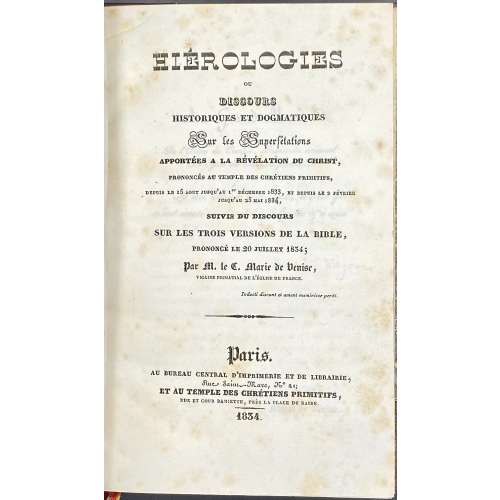 Hardcover volume, 20.7 x 13.5 cm, modern half morocco over marbled boards, gilt lettering and ornament to spine, pp.: [i-vii] viii-xvi [17] 18-255 [256], collated 8vo: 1-168, 128 leaves. Title-page: HIÉROLOGIES | OU | DISCOURS | HISTORIQUES ET DOGMATIQUES | Sur les Superfétations | APPORTÉES A LA RÉVÉLATION DU CHRIST, | PRONONCÉS AU TEMPLE DES CHRÉTIENS PRIMITIFS, | DEPUIS LE 15 AOUT JUSQU’AU 1er DÉCEMBRE 1833, ET DEPUIS LE 2 FÉVRIER | JUSQU’AU 25 MAI 1834, | SUIVIS DU DISCOURS | SUR LES TROIS VERSIONS DE LA BIBLE, | PRONONCÉ LE 20 JUILLET 1834 ; | Par M. le C. Marie de Venise, | VICAIRE PRIMATIAL DE L’EGLISE DE France. | {1 line citation} | — | Paris. | AU BUREAU CENTRAL D’IMPRIMERIE ET DE LIBRAIRE, | Rue Saint-Marc, No 21; | ET AU TEMPLE DES CHRÉTIENS PRIMITIFS, | RUE ET COUR DAMIETTE, PRÈS LA PLACE DU KAIRE. | — | 1834 || Contributors : Félix Ragon (French, 1795 – 1872) – author. Seller's description: [RAGON (Félix) : Hiérologies ou Discours historiques et dogmatiques sur les Superfétations apportées à la révélation du Christ suivis du Discours sur les trois versions de la Bible. Paris, au Bureau central et au Temple des Chrétiens Primitifs, 1834 ; in 8°, demi-basane brune à coins. Reliure pastiche moderne. Edition originale extrêmement rare, dont le tirage est estimé à 50 ex.
Hardcover volume, 20.7 x 13.5 cm, modern half morocco over marbled boards, gilt lettering and ornament to spine, pp.: [i-vii] viii-xvi [17] 18-255 [256], collated 8vo: 1-168, 128 leaves. Title-page: HIÉROLOGIES | OU | DISCOURS | HISTORIQUES ET DOGMATIQUES | Sur les Superfétations | APPORTÉES A LA RÉVÉLATION DU CHRIST, | PRONONCÉS AU TEMPLE DES CHRÉTIENS PRIMITIFS, | DEPUIS LE 15 AOUT JUSQU’AU 1er DÉCEMBRE 1833, ET DEPUIS LE 2 FÉVRIER | JUSQU’AU 25 MAI 1834, | SUIVIS DU DISCOURS | SUR LES TROIS VERSIONS DE LA BIBLE, | PRONONCÉ LE 20 JUILLET 1834 ; | Par M. le C. Marie de Venise, | VICAIRE PRIMATIAL DE L’EGLISE DE France. | {1 line citation} | — | Paris. | AU BUREAU CENTRAL D’IMPRIMERIE ET DE LIBRAIRE, | Rue Saint-Marc, No 21; | ET AU TEMPLE DES CHRÉTIENS PRIMITIFS, | RUE ET COUR DAMIETTE, PRÈS LA PLACE DU KAIRE. | — | 1834 || Contributors : Félix Ragon (French, 1795 – 1872) – author. Seller's description: [RAGON (Félix) : Hiérologies ou Discours historiques et dogmatiques sur les Superfétations apportées à la révélation du Christ suivis du Discours sur les trois versions de la Bible. Paris, au Bureau central et au Temple des Chrétiens Primitifs, 1834 ; in 8°, demi-basane brune à coins. Reliure pastiche moderne. Edition originale extrêmement rare, dont le tirage est estimé à 50 ex. -
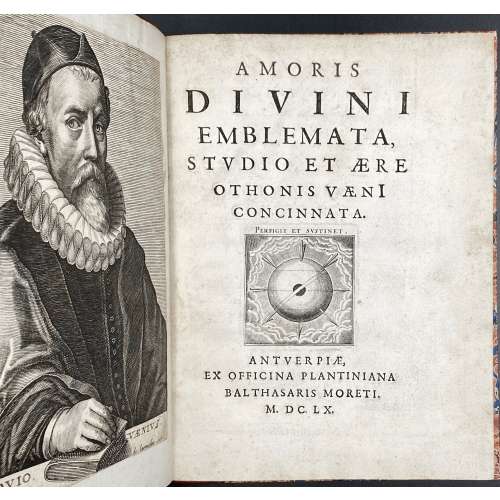 Amoris Divini Emblemata, Studio Et Aere Othonis Vaeni Concinata. — Antverpiae: Ex Officina Plantiniana Balthasaris Moreti, MDCLX [1660]. — pp.: [1] (Van Veen port.), [1] title, [2] (Isabella port.), 3-127 [1], 60 illustr. — 2nd impression. Octavius Vaenius, a.k.a. Otto Vaenius or Otto Van Veen (c. 1556-1629) was Rubens's last and most influential teacher. The Amoris divini emblemata was first published in 1615 by Nutius & Meursius in Antwerp. Vaenius’s book was to influence Herman Hugo's Pia desideria (LIB-1657.2018). Book structure: On frontispiece, trimmed and mounted portrait of Octavius Vaenius painted by his daughter Gertruida van Veen (signed Gertrudis filia) and engraved by Nicolas de Larmessin. Trimmed portrait of the Infanta Isabella Clara of Austria (1566 – 1633) pained by Peter Paul Rubens and engraved by Jan de Leeuw mounted to title verso. 60 engraved plates with emblems are on recto pages with facing texts: Latin quotations from Bible and Fathers, Spanish verses by Alphonso de Ledesma, Dutch by Vaenius and French by Carolus Philippus Hattron (d. 1632). Rebound in the mid-19th century in brown quarter Morocco with blind marbled boards and gilt lettering to spine. Inscription in ink on verso to van Veen portrait: "I bought this volume with the portraits inserted at the sale of the library of my uncle Samuel Rogers, Esq." Signed: "Frederick Sharpe, 1856". Frederick Sharpe (born was a son of Samuel Sharpe (1799–1881), the nephew of Samuel Rogers (1763–1855), a celebrated English poet. Size: 23.3 x 17.9 cm. Ref.: Emblem Project Utrecht (with an explanation of all the emblems); PETER BOOTHUYGENS: Similar or Dissimilar Loves?
Amoris Divini Emblemata, Studio Et Aere Othonis Vaeni Concinata. — Antverpiae: Ex Officina Plantiniana Balthasaris Moreti, MDCLX [1660]. — pp.: [1] (Van Veen port.), [1] title, [2] (Isabella port.), 3-127 [1], 60 illustr. — 2nd impression. Octavius Vaenius, a.k.a. Otto Vaenius or Otto Van Veen (c. 1556-1629) was Rubens's last and most influential teacher. The Amoris divini emblemata was first published in 1615 by Nutius & Meursius in Antwerp. Vaenius’s book was to influence Herman Hugo's Pia desideria (LIB-1657.2018). Book structure: On frontispiece, trimmed and mounted portrait of Octavius Vaenius painted by his daughter Gertruida van Veen (signed Gertrudis filia) and engraved by Nicolas de Larmessin. Trimmed portrait of the Infanta Isabella Clara of Austria (1566 – 1633) pained by Peter Paul Rubens and engraved by Jan de Leeuw mounted to title verso. 60 engraved plates with emblems are on recto pages with facing texts: Latin quotations from Bible and Fathers, Spanish verses by Alphonso de Ledesma, Dutch by Vaenius and French by Carolus Philippus Hattron (d. 1632). Rebound in the mid-19th century in brown quarter Morocco with blind marbled boards and gilt lettering to spine. Inscription in ink on verso to van Veen portrait: "I bought this volume with the portraits inserted at the sale of the library of my uncle Samuel Rogers, Esq." Signed: "Frederick Sharpe, 1856". Frederick Sharpe (born was a son of Samuel Sharpe (1799–1881), the nephew of Samuel Rogers (1763–1855), a celebrated English poet. Size: 23.3 x 17.9 cm. Ref.: Emblem Project Utrecht (with an explanation of all the emblems); PETER BOOTHUYGENS: Similar or Dissimilar Loves? -
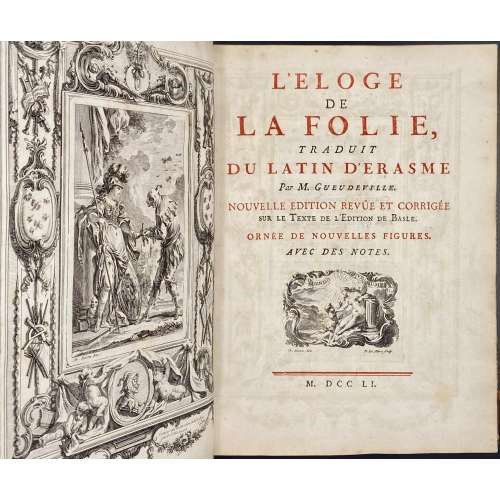 Title: L'ELOGE | DE | LA FOLIE, | TRADUIT | DU LATIN D'ERASME | Par M. Gueudeville. | NOUVELLE EDITION REVÛE & CORRIGÉE | sur le Texte de l'Edition de Basle. | ORNÉE DE NOUVELLES FIGURES. | AVEC DES NOTES. | {vignette Eisen / Le Mire} | — | M. DCC LI. || Pagination: [2 blank] [2] – h.t. / blank, [2] – t.p. / {citation*} | [4] – explication des figures; [i] ii-xxiv, [1] 2-222, [2] – table, [2 blank], plus frontispiece and 13 plates by various engravers after Charles Eisen, total number of pages 10+24+222+4=260, ils. Collation: 4to; [1 blank], π4 a-c4 A-Ee4 [1 blank], total number of leaves 130 plus frontispiece and 13 plates. Plates printed in black, paper 24 x 17.8 cm (grand papeir, 9.5 x 7 inches). Binding: Contemporary mottled calf, triple fillet gilt border with pomegranate corner pieces to boards, spine with raised bands, gilt foliage and pomegranates in compartments, red morocco spine label, all edges gilt, rebacked preserving the original spine and peacock marbled endpapers. Size: 24.8 x 18.8 cm; leaves 24 x 17.8 cm; text printed area: 10 x 6 cm. * Citattion: Admonere voluimus, non lædere: | Consulere moribus Hominum, | non officere. | Erasm. Epist. ad Mart. Dorpium Theolog. Usually, the citation is "Admonere voluimus, non mordere; prodesse, non laedere…", etc. Rococo-framed frontispiece engraved by Martinasie under the supervision of Le Bas. Contributors: Erasmus, Desiderius [Roterodamus] (Dutch, 1466 – 1536) – author. Gueudeville, Nicolas (French, 1652 – 1721) – translator. Meusnier de Querlon, Anne-Gabriel (French, 1702 – 1780) – notes. Eisen, Charles (French, 1720 – 1778) – artist. Engravers: Aliamet, Jacques (French, 1726 – 1788) Flipart, Charles Joseph (French, 1721 – 1797) Beauvais, Nicolas Dauphin de (French, 1687 – 1736) Pinssio [Pincio], Sébastien (French, 1721 – after 1744) Martenasie, Pierre François (French-Flemish, 1729 – 1789) Le Bas [Lebas], Jacques-Philippe (French, 1707 – 1783) Provenance: Bishop, Cortlandt Field (American, 1870 – 1935) – bookplate. Mary S. Collins – bookplate by J. H. Fincken. Robin F. Satinsky (American, 1919 – 2008) – Robin Collection bookplate. Catalogue raisonné: Cohen–deRichi 348-349; Lewine, p. 170; Ray (French) № 24, pp. 52-54.
Title: L'ELOGE | DE | LA FOLIE, | TRADUIT | DU LATIN D'ERASME | Par M. Gueudeville. | NOUVELLE EDITION REVÛE & CORRIGÉE | sur le Texte de l'Edition de Basle. | ORNÉE DE NOUVELLES FIGURES. | AVEC DES NOTES. | {vignette Eisen / Le Mire} | — | M. DCC LI. || Pagination: [2 blank] [2] – h.t. / blank, [2] – t.p. / {citation*} | [4] – explication des figures; [i] ii-xxiv, [1] 2-222, [2] – table, [2 blank], plus frontispiece and 13 plates by various engravers after Charles Eisen, total number of pages 10+24+222+4=260, ils. Collation: 4to; [1 blank], π4 a-c4 A-Ee4 [1 blank], total number of leaves 130 plus frontispiece and 13 plates. Plates printed in black, paper 24 x 17.8 cm (grand papeir, 9.5 x 7 inches). Binding: Contemporary mottled calf, triple fillet gilt border with pomegranate corner pieces to boards, spine with raised bands, gilt foliage and pomegranates in compartments, red morocco spine label, all edges gilt, rebacked preserving the original spine and peacock marbled endpapers. Size: 24.8 x 18.8 cm; leaves 24 x 17.8 cm; text printed area: 10 x 6 cm. * Citattion: Admonere voluimus, non lædere: | Consulere moribus Hominum, | non officere. | Erasm. Epist. ad Mart. Dorpium Theolog. Usually, the citation is "Admonere voluimus, non mordere; prodesse, non laedere…", etc. Rococo-framed frontispiece engraved by Martinasie under the supervision of Le Bas. Contributors: Erasmus, Desiderius [Roterodamus] (Dutch, 1466 – 1536) – author. Gueudeville, Nicolas (French, 1652 – 1721) – translator. Meusnier de Querlon, Anne-Gabriel (French, 1702 – 1780) – notes. Eisen, Charles (French, 1720 – 1778) – artist. Engravers: Aliamet, Jacques (French, 1726 – 1788) Flipart, Charles Joseph (French, 1721 – 1797) Beauvais, Nicolas Dauphin de (French, 1687 – 1736) Pinssio [Pincio], Sébastien (French, 1721 – after 1744) Martenasie, Pierre François (French-Flemish, 1729 – 1789) Le Bas [Lebas], Jacques-Philippe (French, 1707 – 1783) Provenance: Bishop, Cortlandt Field (American, 1870 – 1935) – bookplate. Mary S. Collins – bookplate by J. H. Fincken. Robin F. Satinsky (American, 1919 – 2008) – Robin Collection bookplate. Catalogue raisonné: Cohen–deRichi 348-349; Lewine, p. 170; Ray (French) № 24, pp. 52-54. -
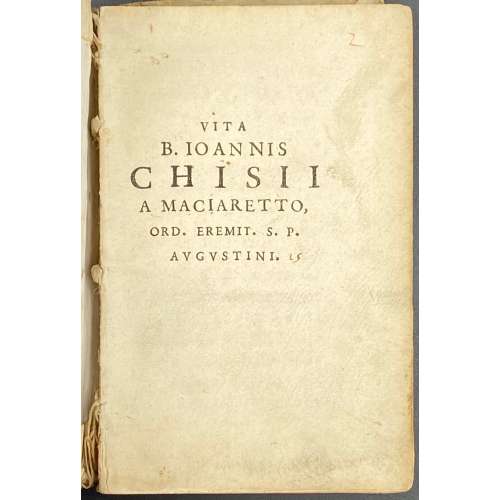 [Michael Hoyer]. Vita B. Ioannis Chisii a Maciaretto, ord. ermit. s. p. Augustini. — Antverpiæ, Apud Henricum Aertssens, Anno MDCXLI [1641]. Pagination: [2] *3+recto unpag. *4+recto unpag., [10], 5-135 [3]. Illustrations: Frontispiece missing, 4 copperplate engravings (pp. 22, 64, 90, and 120) by Pieter de Jode the Younger (1606–1674, Flemish printmaker, draughtsman, painter and art dealer) after Erasmus Quellinus the Younger (1607–1678, Flemish painter, engraver, draughtsman and tapestry designer). Size: Pott 8vo (15.5 x 10 cm), vellum binding. Expanded title: Vita Beati Ioannis Chisii, a Maciaretto, Ordinis Eremitarum Sancti Patris Augustini. [Translation: Life of Blessed Giovanni Chigi from Maciaretto, Order of Hermits of St. Augustine]. Blessed Giovanni Chigi (1300 - 1363) [1] was a lay brother of the Order of Hermits of St. Augustine. The Chigi family is a Roman princely family of Sienese extraction descended from the counts of Ardenghesca. The earliest authentic mention of them is in the 13th century, with one Alemanno, counsellor of the Republic of Siena. The Wikipedia article does not mention Giovanni Chigi, however, it states that one of the Chigi, Cardinal Fabio Chigi, was elected pope as Alexander VII at the Conclave of 1655. The book was published in 1641 with a dedication to the said Cardinal Fabio Chigi before he was elected pope. The town, Maciaretto, where Giovanni Chigi was from, is unclear because there is no such place in modern Italy, and there are two places called Macereto: (1) Macereto Alta/Basso in Perugia province and (2) Macereto in the municipality of Visso, in the province of Macerata, region Marche. I assume that our Giovanni Chigi was from the one that is closer to Siena, i.e. Macereto in Perugia province. Regarding the author. There is no author's name in the book. However, in various sources, the book is mentioned as written by Michel Hoyer, who was born in Hesdin, Flanders in 1593 and died in 1650. He pursued an ecclesiastical career and professed rhetoric at the College of Saint Pierre in Lille. He later joined the Order of Saint Augustine, in the convent of Ypres, and settled in various schools in the Netherlands. His reputation attracted many students, among them Albert Rubens (1614–1657), the eldest son of Peter Paul Rubens and Isabella Brant. Michel Hoyer wrote several books, the most known is Flammulae amoris, S.P. Augustini versibus et iconibus exornatae:
[Michael Hoyer]. Vita B. Ioannis Chisii a Maciaretto, ord. ermit. s. p. Augustini. — Antverpiæ, Apud Henricum Aertssens, Anno MDCXLI [1641]. Pagination: [2] *3+recto unpag. *4+recto unpag., [10], 5-135 [3]. Illustrations: Frontispiece missing, 4 copperplate engravings (pp. 22, 64, 90, and 120) by Pieter de Jode the Younger (1606–1674, Flemish printmaker, draughtsman, painter and art dealer) after Erasmus Quellinus the Younger (1607–1678, Flemish painter, engraver, draughtsman and tapestry designer). Size: Pott 8vo (15.5 x 10 cm), vellum binding. Expanded title: Vita Beati Ioannis Chisii, a Maciaretto, Ordinis Eremitarum Sancti Patris Augustini. [Translation: Life of Blessed Giovanni Chigi from Maciaretto, Order of Hermits of St. Augustine]. Blessed Giovanni Chigi (1300 - 1363) [1] was a lay brother of the Order of Hermits of St. Augustine. The Chigi family is a Roman princely family of Sienese extraction descended from the counts of Ardenghesca. The earliest authentic mention of them is in the 13th century, with one Alemanno, counsellor of the Republic of Siena. The Wikipedia article does not mention Giovanni Chigi, however, it states that one of the Chigi, Cardinal Fabio Chigi, was elected pope as Alexander VII at the Conclave of 1655. The book was published in 1641 with a dedication to the said Cardinal Fabio Chigi before he was elected pope. The town, Maciaretto, where Giovanni Chigi was from, is unclear because there is no such place in modern Italy, and there are two places called Macereto: (1) Macereto Alta/Basso in Perugia province and (2) Macereto in the municipality of Visso, in the province of Macerata, region Marche. I assume that our Giovanni Chigi was from the one that is closer to Siena, i.e. Macereto in Perugia province. Regarding the author. There is no author's name in the book. However, in various sources, the book is mentioned as written by Michel Hoyer, who was born in Hesdin, Flanders in 1593 and died in 1650. He pursued an ecclesiastical career and professed rhetoric at the College of Saint Pierre in Lille. He later joined the Order of Saint Augustine, in the convent of Ypres, and settled in various schools in the Netherlands. His reputation attracted many students, among them Albert Rubens (1614–1657), the eldest son of Peter Paul Rubens and Isabella Brant. Michel Hoyer wrote several books, the most known is Flammulae amoris, S.P. Augustini versibus et iconibus exornatae: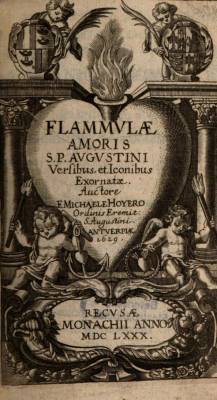 Surprisingly, there is only limited information about Michel Hoyer in Spanish Wikipedia; other language versions of his biography do not exist. Another author mentioned in the book is some anonymous Augustinian from Cologne.
Regarding the illustrations. In our copy, the frontispiece is missing. It was probably ripped off by some unscrupulous seller of antique prints.
The image on the missing frontispiece is this:
Surprisingly, there is only limited information about Michel Hoyer in Spanish Wikipedia; other language versions of his biography do not exist. Another author mentioned in the book is some anonymous Augustinian from Cologne.
Regarding the illustrations. In our copy, the frontispiece is missing. It was probably ripped off by some unscrupulous seller of antique prints.
The image on the missing frontispiece is this:
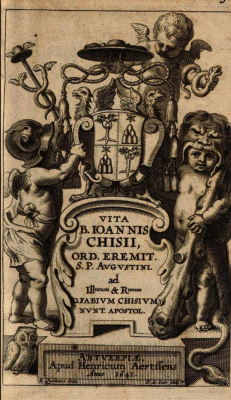 The names of the artists engraved in the bottom of the stone: E. Quellinus, delin. to the left and P. de Jode, fecit. to the right. We can infer that the other illustrations in that book are produced by the same duo. The image represents three cherubs: one with Athena's serpent in his left hand and a cardinal's hat in his right hand; another in Athen's helmet on his head and her owl beside his feet, with the staff of Mercurius (serpent-twined staff adorned with a winged hat) in his left hand, and the House of Chigi - Della Rovere coat of arms in his right hand; the third cherub depicted with the Hercules attributes - lion pelt and a club.
Regarding the publisher. Henricum Aertssens or Hendrik Aertssen, 1586-1658. Besides the other books, he published PIA DESIDERIA by Herman Hugo in 1636 [1621 french edition by Jean Cnobbartin in Antwerp in his collection LIB-1657.2018]. According to Nina Lamal [2], nothing is known about career of this publisher, besides what's said in Adresboek van zeventiende-eeuwse drukkers, uitgevers en boekverkopers in Vlaanderen / Directory of seventeenth-century Printers, Publishers and Booksellers in Flanders / Vlieger-De Wilde, Koen De (editor). The list of his publications can be seen here.
Other artists who turned to the figure of Blessed Giovanni Chigi were Abraham van Diepenbeeck (painter) and Conrad Lauwers (engraver). The print is in Rijksmuseum, in Amsterdam.
The names of the artists engraved in the bottom of the stone: E. Quellinus, delin. to the left and P. de Jode, fecit. to the right. We can infer that the other illustrations in that book are produced by the same duo. The image represents three cherubs: one with Athena's serpent in his left hand and a cardinal's hat in his right hand; another in Athen's helmet on his head and her owl beside his feet, with the staff of Mercurius (serpent-twined staff adorned with a winged hat) in his left hand, and the House of Chigi - Della Rovere coat of arms in his right hand; the third cherub depicted with the Hercules attributes - lion pelt and a club.
Regarding the publisher. Henricum Aertssens or Hendrik Aertssen, 1586-1658. Besides the other books, he published PIA DESIDERIA by Herman Hugo in 1636 [1621 french edition by Jean Cnobbartin in Antwerp in his collection LIB-1657.2018]. According to Nina Lamal [2], nothing is known about career of this publisher, besides what's said in Adresboek van zeventiende-eeuwse drukkers, uitgevers en boekverkopers in Vlaanderen / Directory of seventeenth-century Printers, Publishers and Booksellers in Flanders / Vlieger-De Wilde, Koen De (editor). The list of his publications can be seen here.
Other artists who turned to the figure of Blessed Giovanni Chigi were Abraham van Diepenbeeck (painter) and Conrad Lauwers (engraver). The print is in Rijksmuseum, in Amsterdam.
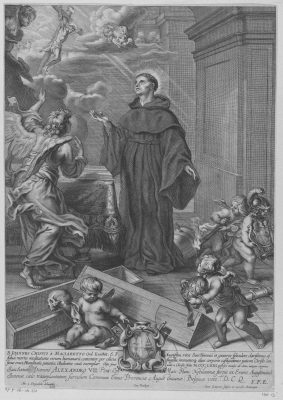 Here we see a more complex composition but with a clear reference to the work of Quellinus and de Jode: The cherub in Athena's helmet takes away the old coat of arms of the Chigi, and the other cherub points out to the new one, with papal symbols of St. Peter's keys, another cherub carries the papal tiara. Rijksmuseum dates the image as 1642 - 1685; most probably it is ca. 1655, when Fabio Chigi became Pope Alexander VII, and propaganda was focused on promoting his outstanding ancestor Giovanni, who died 300 years before. Giovanni Chigi is depicted here resurrected, accompanied by the archangel, and receiving the blessing from Jesus on the cross.
1 - Michael J. Walsh. A New Dictionary of Saints: East and West, p. 308.
2 - Nina Lamal. Publishing military books in the Low Countries and in Italy in the early seventeenth century in 'Specialist Markets in the Early Modern Book World', ed. Richard Kirwan, Sophia Mullins, Leiden: Koninklijke Brill, 2015, pp. 232-233.
Here we see a more complex composition but with a clear reference to the work of Quellinus and de Jode: The cherub in Athena's helmet takes away the old coat of arms of the Chigi, and the other cherub points out to the new one, with papal symbols of St. Peter's keys, another cherub carries the papal tiara. Rijksmuseum dates the image as 1642 - 1685; most probably it is ca. 1655, when Fabio Chigi became Pope Alexander VII, and propaganda was focused on promoting his outstanding ancestor Giovanni, who died 300 years before. Giovanni Chigi is depicted here resurrected, accompanied by the archangel, and receiving the blessing from Jesus on the cross.
1 - Michael J. Walsh. A New Dictionary of Saints: East and West, p. 308.
2 - Nina Lamal. Publishing military books in the Low Countries and in Italy in the early seventeenth century in 'Specialist Markets in the Early Modern Book World', ed. Richard Kirwan, Sophia Mullins, Leiden: Koninklijke Brill, 2015, pp. 232-233.
-
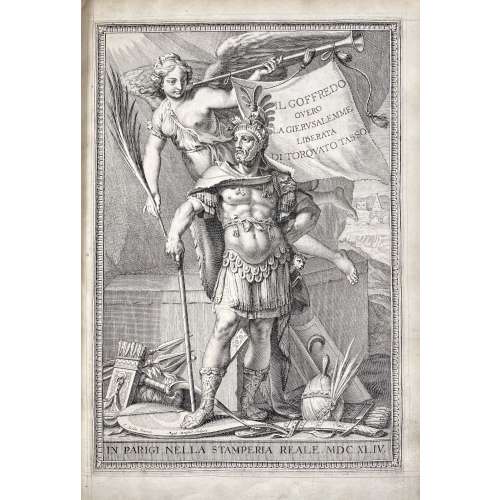 Title page: IL | GOFFREDO | OVERO | LA | GIERUSALEMME | LIBERATA | DI TORQUATO TASSO. || Engraved title: On the banner: IL GOFFREDO | OVERO | LA GIERUSALEMME | LIBERATA | DI TORQUATO TASSO ||; under the image, within frame: IN PARIGI NELLA STAMPERIA REALE MDC XLIV. Signed: J. Stella Invenit — Ægid Rousselet Sculpsit (with tall “s”) || Collation: 2 blank leaves with donation ink inscription to recto of the 1st: “Ex Dono Patruelis Do Roberto Willughby” [i.e. Robert Willoughby]; t.p. / blank, engraved t.p. by Gilles Rousselet after Jacques Stella / blank, “Allegoria dell poema” 4 leaves, 1st two leaves signed iij and iiij, respectively; π6 A-Z4 Aa-Zz4 Aaa-Rrr4, 2 blank leaves at the end; text paginated from 1 to 502 [2] (p. 503 tailpiece, p. 504 blank); a printable area marked with vertical and horizontal double lines; total: 252 leaves of text (504 pages), 6 prelims and 4 blanks. Illustrated throughout with head- and tailpieces, and historiated initials. Binding: 18th-century red crushed morocco, triple-fillet gilt border, triple-fillet gilt frame, panel with gilt lozenge centrepiece, lozenges at corners, marbled endpapers, AEG, crudely rebacked retaining original spine with raised bands, gilt in compartments, crimson label with gilt lettering; The Robin Collection bookplate to front pastedown. Provenance: The Robin Collection; Robert Willoughby family. Contributors: Torquato Tasso (Italian, 1544 –1595) – author. Jacques Stella (French, 1596 – 1657) – artist. Gilles [Aegidius] Rousselet (French, 1610 – 1686) – engraver.
Title page: IL | GOFFREDO | OVERO | LA | GIERUSALEMME | LIBERATA | DI TORQUATO TASSO. || Engraved title: On the banner: IL GOFFREDO | OVERO | LA GIERUSALEMME | LIBERATA | DI TORQUATO TASSO ||; under the image, within frame: IN PARIGI NELLA STAMPERIA REALE MDC XLIV. Signed: J. Stella Invenit — Ægid Rousselet Sculpsit (with tall “s”) || Collation: 2 blank leaves with donation ink inscription to recto of the 1st: “Ex Dono Patruelis Do Roberto Willughby” [i.e. Robert Willoughby]; t.p. / blank, engraved t.p. by Gilles Rousselet after Jacques Stella / blank, “Allegoria dell poema” 4 leaves, 1st two leaves signed iij and iiij, respectively; π6 A-Z4 Aa-Zz4 Aaa-Rrr4, 2 blank leaves at the end; text paginated from 1 to 502 [2] (p. 503 tailpiece, p. 504 blank); a printable area marked with vertical and horizontal double lines; total: 252 leaves of text (504 pages), 6 prelims and 4 blanks. Illustrated throughout with head- and tailpieces, and historiated initials. Binding: 18th-century red crushed morocco, triple-fillet gilt border, triple-fillet gilt frame, panel with gilt lozenge centrepiece, lozenges at corners, marbled endpapers, AEG, crudely rebacked retaining original spine with raised bands, gilt in compartments, crimson label with gilt lettering; The Robin Collection bookplate to front pastedown. Provenance: The Robin Collection; Robert Willoughby family. Contributors: Torquato Tasso (Italian, 1544 –1595) – author. Jacques Stella (French, 1596 – 1657) – artist. Gilles [Aegidius] Rousselet (French, 1610 – 1686) – engraver.


